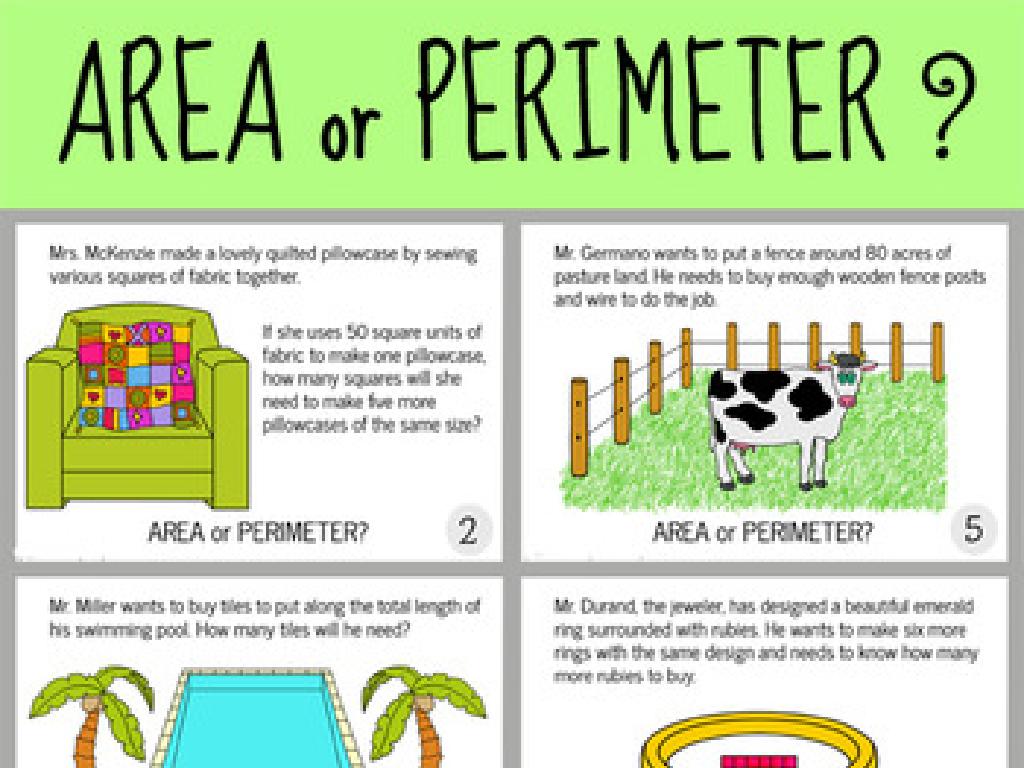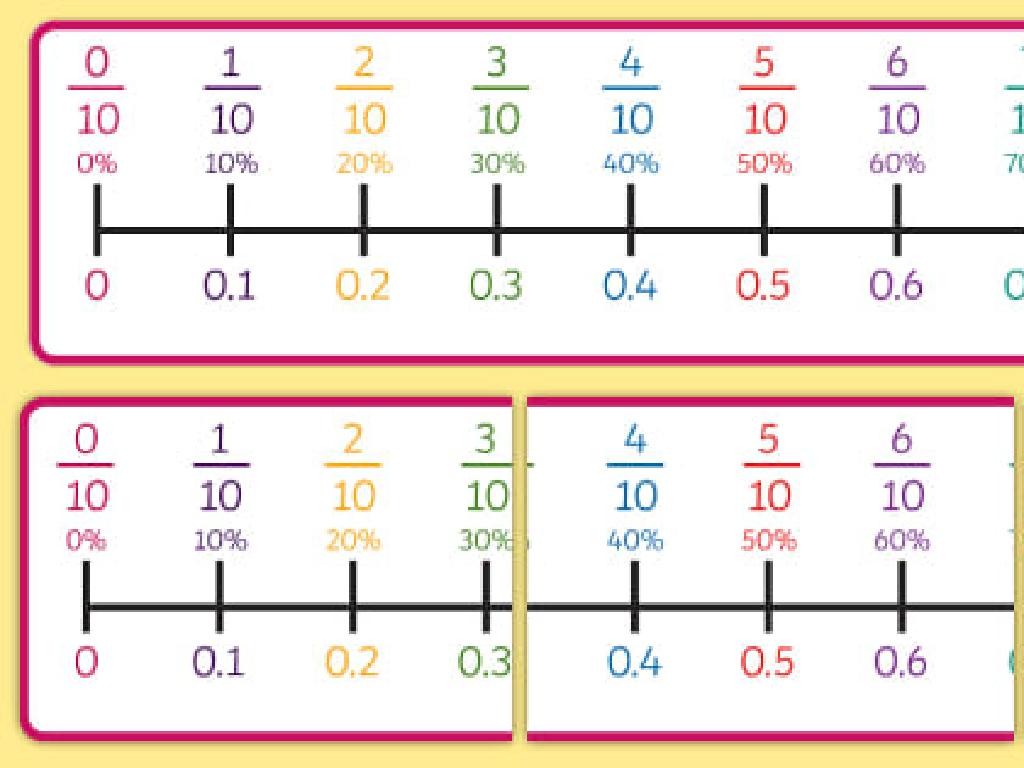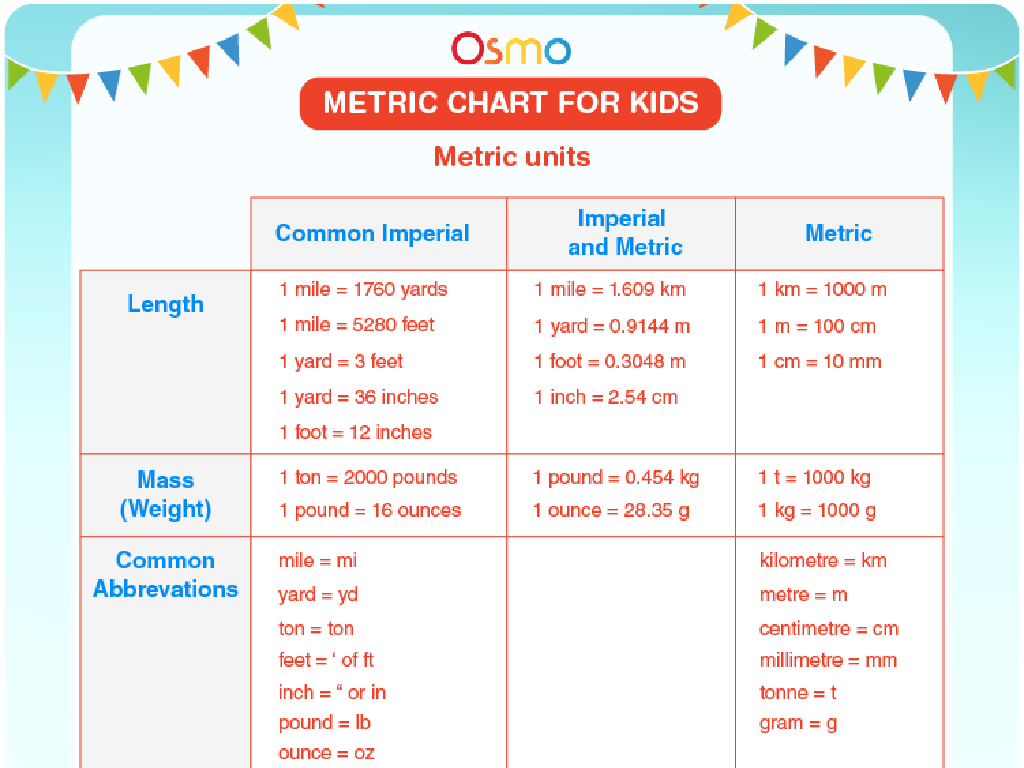Divisibility Rules: Word Problems
Subject: Math
Grade: Fourth grade
Topic: Factors And Multiples
Please LOG IN to download the presentation. Access is available to registered users only.
View More Content
Welcome to Divisibility!: Today’s Adventure
– Discovering divisibility rules
– Rules that help us know if a number is divisible by another without dividing
– Exploring factors and multiples
– Factors are numbers we can multiply to get another number; multiples are what we get after multiplying
– Applying rules to simplify math
– Use rules to quickly solve problems, like knowing if 15 is divisible by 3 or 5
– Divisibility makes math fun!
|
This slide introduces the concept of divisibility rules, which are shortcuts that help us determine if one number is divisible by another without doing long division. Understanding factors and multiples is crucial as they are the building blocks of divisibility. Factors are numbers we multiply together to get another number, while multiples are the product of multiplying a number by an integer. By applying divisibility rules, students can simplify complex math problems and make math more enjoyable. Encourage students to think of these rules as detective tools that help them solve math mysteries quickly and efficiently.
Understanding Divisibility
– What does ‘divisible’ mean?
– If a number divides evenly into another, it’s divisible.
– Examples of divisibility
– 10 divided by 2 equals 5 with no remainder.
– Non-examples of divisibility
– 10 divided by 3 leaves a remainder, not divisible.
– Practice finding divisibility
|
This slide introduces the concept of divisibility, which is fundamental to understanding factors and multiples. Divisibility means that one number can be divided by another without leaving any remainder. For example, 10 is divisible by 2 because it divides evenly to give 5. However, 10 is not divisible by 3 because it leaves a remainder of 1. It’s important for students to grasp this concept as it will help them with more complex math problems involving division. Encourage students to practice with different numbers to see if they are divisible by 2, 3, 5, etc., and to explain their reasoning.
Divisibility by 2: Understanding Even Numbers
– Divisible by 2 means it’s even
– Even numbers end in 0, 2, 4, 6, or 8
– Example: Is 14 divisible by 2?
– Yes, 14 ends in 4, so it’s divisible by 2
– Practice with different numbers
– Try checking if 22, 35, and 48 are divisible by 2
|
This slide introduces the concept of divisibility by 2, focusing on even numbers. Explain that a number is divisible by 2 if it ends in 0, 2, 4, 6, or 8, which are all even numbers. Use the example of 14 to show how the last digit, 4, indicates it is divisible by 2. Encourage students to practice with more numbers to solidify their understanding. For instance, 22 and 48 are divisible by 2 because they end in 2 and 8 respectively, while 35 is not because it ends in 5, which is not an even number. This exercise will help students become more comfortable with the rule and how to apply it to different numbers.
Divisibility by 3: Understanding Through Word Problems
– Rule for divisibility by 3
– Add digits together; if sum is divisible by 3, so is the number
– Example with number 21
– For 21, 2 + 1 = 3, which is divisible by 3, so 21 is divisible by 3
– Testing number 25
– For 25, 2 + 5 = 7, which is not divisible by 3, so 25 isn’t either
– Practice with your own numbers
|
This slide introduces the concept of divisibility by 3 through simple word problems. Start by explaining the rule: a number is divisible by 3 if the sum of its digits is divisible by 3. Use 21 as a clear example, showing that 2 plus 1 equals 3, which is divisible by 3, hence 21 is also divisible by 3. Then, challenge the students with 25, where the sum of the digits is 7, not divisible by 3, indicating that 25 is not divisible by 3. Encourage students to apply this rule by finding and testing numbers on their own, fostering interactive learning.
Divisibility by 5: Understanding the Rule
– Rule for divisibility by 5
– Ends in 0 or 5? Then it’s divisible by 5!
– Example: 45 is divisible by 5
– 45 ends in 5, so it can be divided by 5 evenly.
– Non-example: 47 isn’t divisible by 5
– 47 ends in 7, so it’s not divisible by 5.
– Practice with different numbers
– Try numbers like 30, 65, or 82 to see if they follow the rule.
|
This slide introduces the simple rule for divisibility by 5, aimed at helping fourth graders quickly determine if a number can be divided by 5 without a remainder. Start by explaining that if the last digit of a number is 0 or 5, the number is divisible by 5. Provide clear examples and non-examples to illustrate the concept. Encourage students to practice with various numbers to reinforce the rule. During the next class, you can have students share numbers they’ve found that are divisible by 5 and explain how they used the rule to figure it out.
Divisibility by 10: Word Problems
– Rule for divisibility by 10
– A number can be divided by 10 if its last digit is 0
– Example: 60 is divisible by 10
– Since 60 ends with a 0, it can be divided by 10 evenly
– Non-example: 63 isn’t divisible by 10
– 63 ends with a 3, so it cannot be divided by 10 without a remainder
– Practice with different numbers
|
This slide introduces the concept of divisibility, specifically focusing on the rule for divisibility by 10. It’s crucial for students to understand that a number ending in 0 can be evenly divided by 10. Provide clear examples and non-examples to illustrate the rule. Encourage students to look at the last digit of a number to determine if it’s divisible by 10. For the class activity, have students practice with a list of numbers, identifying which are divisible by 10 and which are not. This will help solidify their understanding of the concept through practical application.
Divisibility in Real Life: Sharing Apples
– Apply divisibility to real problems
– Example: 24 apples among 6 friends
– If each friend gets the same number, how many does each get?
– Can we divide them equally?
– Divisibility tells us if 24 can be split by 6 without leftovers.
– Let’s solve it together!
– We’ll use division to find out the answer.
|
This slide introduces students to the practical application of divisibility rules through a relatable scenario involving sharing apples among friends. The goal is to determine if 24 apples can be divided equally among 6 friends. This example will help students understand the concept of divisibility and how it can be used to solve real-world problems. Encourage the students to think about the problem and predict the outcome before solving it. As a teacher, guide them through the process of dividing 24 by 6, explaining that if the result is a whole number, the apples can be divided equally. This exercise will reinforce their understanding of divisibility and division. Prepare to discuss different scenarios and numbers to further practice divisibility rules.
Class Activity: Divisibility Detective
– Become a Divisibility Detective!
– Find divisible numbers in class
– Look for numbers divisible by 2, 3, 5, and 10
– Pair up for divisibility mysteries
– Work with a partner to find clues
– Solve and explain your findings
– Share how you solved the mystery with the class
|
In this engaging class activity, students will pair up and search for numbers in the classroom environment that are divisible by 2, 3, 5, and 10. They will act as ‘Divisibility Detectives’ and use their knowledge of divisibility rules to solve ‘mysteries.’ Each pair will be tasked with finding examples of divisible numbers, such as page numbers in books, dates on the calendar, or numbers on classroom objects. After the search, pairs will explain the reasoning behind their findings to the class, reinforcing their understanding of divisibility rules. Possible activities include: finding the total number of objects divisible by a certain number, creating a poster with divisible numbers found, or writing a short story involving divisibility clues they discovered.
Detectives of Divisibility: Conclusion & Homework
– Congrats on your detective work!
– Review today’s divisibility rules
– Rules like 2’s (even numbers), 3’s (sum of digits), 5’s (ending in 0 or 5)
– Homework: Divisibility Worksheet
– Practice applying the rules to different numbers
– Be ready to discuss your answers
– We’ll go over the tricky problems together
|
Well done to all the students for their hard work in today’s lesson on divisibility rules. As a conclusion, remind them of the key rules they’ve learned and how they can be used to solve word problems. For homework, the students are assigned a Divisibility Worksheet to reinforce their understanding. Encourage them to try their best and remind them that we will review the answers in the next class, providing an opportunity to clarify any doubts. This will help solidify their learning and prepare them for more complex problems in the future.





